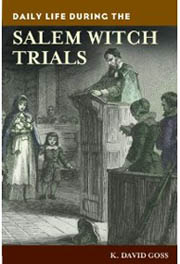Colonel John Hathorne
-age 51 years, born 1641 in Salem, MA
-father was Major William Hathorne, most powerful magistrate in Salem
-at age 21, his father gave him small portion of Mill Pond Farm on edge of Salem Town
-had 2 younger sisters, Ann and Elizabeth—both married into Porter family
-had 3 brothers who all died mysteriously (Eleazer, Nathaniel and William)
-Nathaniel died in his 20’s
-Captain William, Jr. died at 33 with no children
-Eleazer died at age 43. He had 3 children
-in 1665, purchased 900 acres of land from Indian (Robin Hood) in Maine, but lost it in 1690 to the French and Indians in the War
-he then purchased a ship to keep in the harbor in Salem for his shipping trade
-was a merchant and also obtained high military rank
-Hathorne lived at 114 Washington St. in 1692
-had been deputy of the General Court, a member of the Court of Assistants (although he apparently was not at Bridget’s 1680 trial) and a Councillor.
-BUT he had no formal training in law.
-was licensed to sell liquors from 1676 to 1681
-was a town selectman, and in 1680, voted for a new meetinghouse to be built because the one they had was “insufficient” in that it was too small (therefore, according to the selectman, a large number of people were not attending services. However, another faction in town was opposed to this, and a new meetinghouse in the town was not built.
-In 1681, was granted a tract of land along the wharf to build a warehouse on
-In 1683, was elected Deputy (a member of the lower legislative chamber)
-In 1684, was elected magistrate, an assistant to the governor (a member of the upper legislative chamber)
-In 1684, served as a judge, along with 6 others, in the trial against a man who had robbed Captain Corwin. His name is recorded as “John Hathorne, Esq., of Salem.”
-In April 1690, Hathorne and Corwin were sent by Gov. Bradstreet to the eastern parts, particularly Maine, to perpetuate the settlements against the Indians.
-In October 1691, Hathorne was named a Councillor or Assistant in the new charter. This meant that he was one of 28 men who were able to appoint (along with William and Maty) a Governor, Deputy Gov. and Secretary of the Province.
-They appointed Sir William Phips, born in Maine in 1651.
-In 1692, his job as magistrate meant he had to try legal cases (criminal and civil) and pass sentence. Magistrates were the highest legal authority in the town.
-The other two Salem magistrates were Jonathan Corwin and Bartholomew Gedney.
-On April 22, 1692, Hathorne acquitted Nehe’miah Abbott, Jr., the only accused witch acquitted in Salem.
-Hathorne and Corwin issued the first warrants for arrest.
-He was not one of the judges on June 2, but continued with the preliminary examinations.
-When a new Superior Court of Judicature was set up in Dec., 1692, Hathorne was not elected one of the judges.
-In 1696, he was offered a position to conduct an expedition to St. John’s River, which he accepted.
-He died in 1717 and is buried in Charter St. Burial Grounds in Salem.






Comments on this entry are closed.